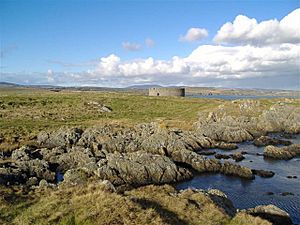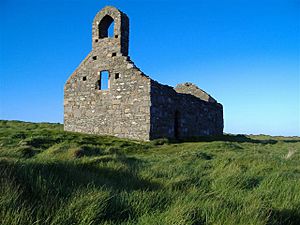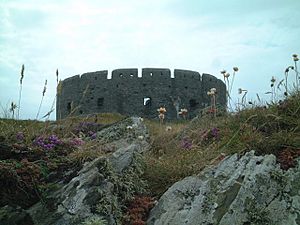St Michael's Isle facts for kids
St Michael's Isle, often called Fort Island, is a small island in the Isle of Man. Its Manx Gaelic names are Ellan Noo Mael or Ynnys Vaayl. The island is famous for its old buildings that are now ruins.
This island is about 400 meters (1,300 feet) long from west to east. It covers an area of about 5.14 hectares (12.7 acres). A narrow path, called a causeway, connects it to the Langness Peninsula near Derbyhaven. The island's ground is made of rocky slate and is quite acidic. Even so, many special plants that grow near the sea thrive here.
People have lived or visited St Michael's Isle for a very long time, since the Stone Age. There are two old buildings on the island. Both are in ruins and visitors cannot go inside them. However, there are walking paths that let you explore the areas around these historic sites.
Contents
What is St Michael's Chapel?
St Michael's Chapel is a very old church building from the 12th century. It is located on the south side of the island. This chapel shows a mix of Celtic and Norse building styles. It was built on the spot where an even older Celtic church, called a keeill in Manx Gaelic, once stood.
What Battles Happened on the Island?
St Michael's Isle was the location of two important battles. These fights were for control of the Isle of Man. In 1250, the Manx people fought against England and Scotland and won. But 25 years later, in 1275, they lost control of the island to Scotland.
What is Derby Fort?
Derby Fort is a 17th-century fort found at the eastern end of the island. James Stanley, who was the Lord of Mann, built it in 1645. This happened during the English Civil War. The fort's main job was to protect the busy port of Derbyhaven nearby.
Why is Fort Island Important for Nature?
Today, St Michael's Isle is a special place for birds. It is a bird sanctuary, which means it's a safe home for many different kinds of birds.




